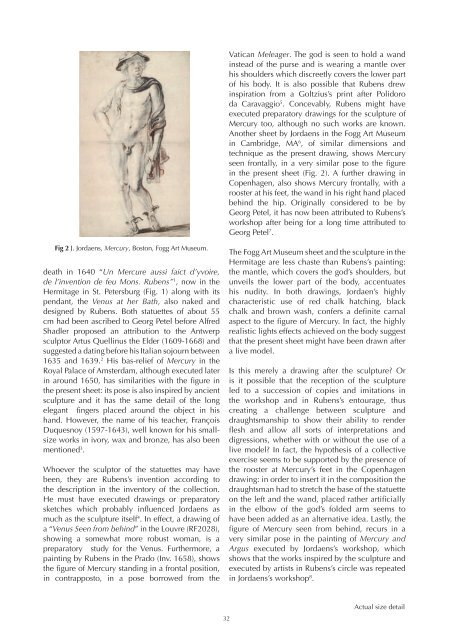XV - Works On Paper - Marty de Cambiaire (English)
Create successful ePaper yourself
Turn your PDF publications into a flip-book with our unique Google optimized e-Paper software.
Vatican Meleager. The god is seen to hold a wand<br />
instead of the purse and is wearing a mantle over<br />
his shoul<strong>de</strong>rs which discreetly covers the lower part<br />
of his body. It is also possible that Rubens drew<br />
inspiration from a Goltzius’s print after Polidoro<br />
da Caravaggio 5 . Concevably, Rubens might have<br />
executed preparatory drawings for the sculpture of<br />
Mercury too, although no such works are known.<br />
Another sheet by Jordaens in the Fogg Art Museum<br />
in Cambridge, MA 6 , of similar dimensions and<br />
technique as the present drawing, shows Mercury<br />
seen frontally, in a very similar pose to the figure<br />
in the present sheet (Fig. 2). A further drawing in<br />
Copenhagen, also shows Mercury frontally, with a<br />
rooster at his feet, the wand in his right hand placed<br />
behind the hip. Originally consi<strong>de</strong>red to be by<br />
Georg Petel, it has now been attributed to Rubens’s<br />
workshop after being for a long time attributed to<br />
Georg Petel 7 .<br />
Fig 2 J. Jordaens, Mercury, Boston, Fogg Art Museum.<br />
<strong>de</strong>ath in 1640 “Un Mercure aussi faict d’yvoire,<br />
<strong>de</strong> l’invention <strong>de</strong> feu Mons. Rubens” 1 , now in the<br />
Hermitage in St. Petersburg (Fig. 1) along with its<br />
pendant, the Venus at her Bath, also naked and<br />
<strong>de</strong>signed by Rubens. Both statuettes of about 55<br />
cm had been ascribed to Georg Petel before Alfred<br />
Shadler proposed an attribution to the Antwerp<br />
sculptor Artus Quellinus the El<strong>de</strong>r (1609-1668) and<br />
suggested a dating before his Italian sojourn between<br />
1635 and 1639. 2 His bas-relief of Mercury in the<br />
Royal Palace of Amsterdam, although executed later<br />
in around 1650, has similarities with the figure in<br />
the present sheet: its pose is also inspired by ancient<br />
sculpture and it has the same <strong>de</strong>tail of the long<br />
elegant fingers placed around the object in his<br />
hand. However, the name of his teacher, François<br />
Duquesnoy (1597-1643), well known for his smallsize<br />
works in ivory, wax and bronze, has also been<br />
mentioned 3 .<br />
Whoever the sculptor of the statuettes may have<br />
been, they are Rubens’s invention according to<br />
the <strong>de</strong>scription in the inventory of the collection.<br />
He must have executed drawings or preparatory<br />
sketches which probably influenced Jordaens as<br />
much as the sculpture itself 4 . In effect, a drawing of<br />
a “Venus Seen from behind” in the Louvre (RF2028),<br />
showing a somewhat more robust woman, is a<br />
preparatory study for the Venus. Furthermore, a<br />
painting by Rubens in the Prado (Inv. 1658), shows<br />
the figure of Mercury standing in a frontal position,<br />
in contrapposto, in a pose borrowed from the<br />
The Fogg Art Museum sheet and the sculpture in the<br />
Hermitage are less chaste than Rubens’s painting:<br />
the mantle, which covers the god’s shoul<strong>de</strong>rs, but<br />
unveils the lower part of the body, accentuates<br />
his nudity. In both drawings, Jordaen’s highly<br />
characteristic use of red chalk hatching, black<br />
chalk and brown wash, confers a <strong>de</strong>finite carnal<br />
aspect to the figure of Mercury. In fact, the highly<br />
realistic lights effects achieved on the body suggest<br />
that the present sheet might have been drawn after<br />
a live mo<strong>de</strong>l.<br />
Is this merely a drawing after the sculpture? Or<br />
is it possible that the reception of the sculpture<br />
led to a succession of copies and imitations in<br />
the workshop and in Rubens’s entourage, thus<br />
creating a challenge between sculpture and<br />
draughtsmanship to show their ability to ren<strong>de</strong>r<br />
flesh and allow all sorts of interpretations and<br />
digressions, whether with or without the use of a<br />
live mo<strong>de</strong>l? In fact, the hypothesis of a collective<br />
exercise seems to be supported by the presence of<br />
the rooster at Mercury’s feet in the Copenhagen<br />
drawing: in or<strong>de</strong>r to insert it in the composition the<br />
draughtsman had to stretch the base of the statuette<br />
on the left and the wand, placed rather artificially<br />
in the elbow of the god’s fol<strong>de</strong>d arm seems to<br />
have been ad<strong>de</strong>d as an alternative i<strong>de</strong>a. Lastly, the<br />
figure of Mercury seen from behind, recurs in a<br />
very similar pose in the painting of Mercury and<br />
Argus executed by Jordaens’s workshop, which<br />
shows that the works inspired by the sculpture and<br />
executed by artists in Rubens’s circle was repeated<br />
in Jordaens’s workshop 8 .<br />
32<br />
Actual size <strong>de</strong>tail
















